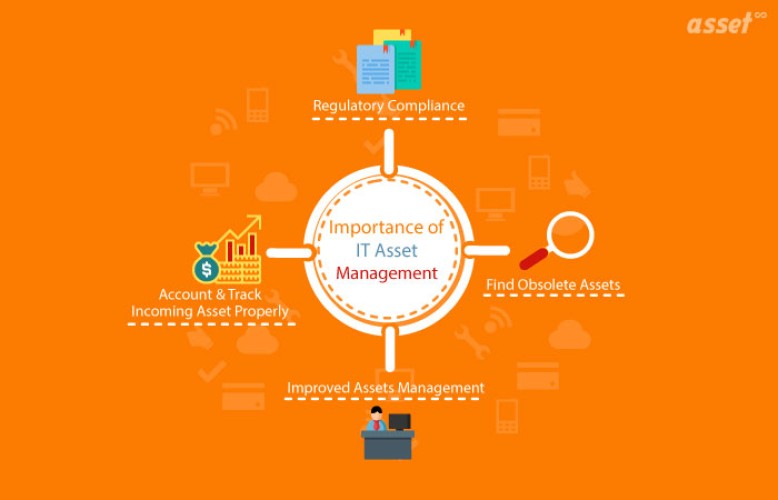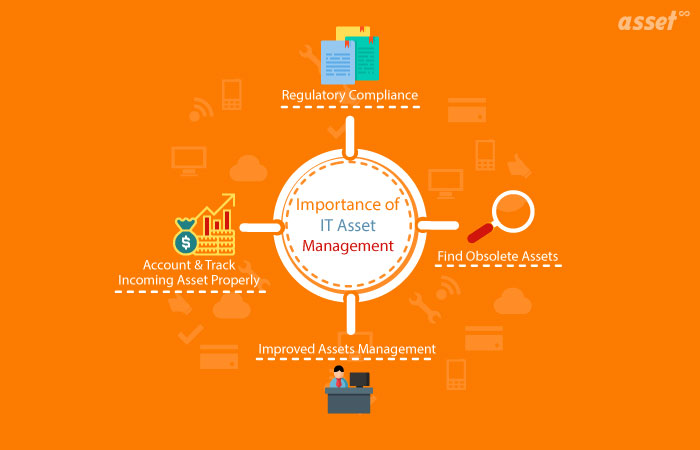
Why Is IT Asset Management Important?
Why is IT asset management important? Well, have you ever wondered how companies keep track of all their computers, software, and other technology? That's where IT asset management comes in! It's like having a superhero keeping tabs on all the valuable tech stuff.
Think about it this way: Imagine you have a bunch of toys, and you want to make sure you don't lose any of them. You might organize them in a special box or keep a list of all the toys you have. That's exactly what IT asset management does, but instead of toys, it's all about the tools that companies need to run smoothly.
By keeping track of their technology assets, companies can save money, increase efficiency, and prevent any surprises when it comes to their tech. So let's dive in and explore why IT asset management is so important for businesses big and small!

Why is IT Asset Management Important?
Managing the assets of an organization is essential for smooth operations and optimal productivity. In the modern digital age, IT asset management has become increasingly crucial for businesses of all sizes. This article will explore the importance of IT asset management and how it can benefit organizations in various ways.
The Benefits of IT Asset Management
Effective IT asset management provides numerous benefits for businesses. By implementing a comprehensive asset management system, organizations can gain better control over their IT infrastructure, improve efficiency, reduce costs, and enhance security.
1. Control over IT Infrastructure
IT asset management allows businesses to gain complete visibility and control over their IT infrastructure. This includes hardware, software, licenses, and other digital assets. With a centralized asset management system, organizations can easily track assets, view their lifecycle information, monitor usage, and ensure compliance with licensing and regulatory requirements.
Furthermore, having a clear overview of IT assets enables organizations to make informed decisions about upgrades, replacements, and investments in new technologies.
2. Improved Efficiency and Productivity
Efficient IT asset management leads to improved productivity by optimizing resource allocation, streamlining processes, and reducing downtime. By accurately tracking assets and their usage, organizations can identify redundant or underutilized resources and reallocate them to areas of higher demand. This ensures that the right resources are available when needed, maximizing the potential of the IT infrastructure.
Additionally, asset management helps minimize downtime by enabling proactive maintenance and monitoring of assets. Regular software updates, patches, and timely repairs can be scheduled, reducing the risk of system failures and minimizing the impact on productivity.
3. Cost Reduction
Implementing an effective IT asset management strategy can lead to significant cost savings for businesses. By accurately tracking and managing assets, organizations can avoid overspending on unnecessary software licenses, equipment, and maintenance contracts.
Asset management also helps prevent unplanned expenses that may arise from system failures or non-compliance with licensing agreements. By being proactive in monitoring assets and identifying potential issues, organizations can reduce the risk of costly repairs or legal penalties.
4. Enhanced Security
IT asset management plays a vital role in enhancing the overall security posture of an organization. By knowing what assets are in use, their location, and their vulnerability to cybersecurity threats, businesses can enforce stronger security measures.
Asset management enables organizations to implement robust access controls, deploy security patches and updates in a timely manner, and monitor for any unauthorized changes or incidents. This proactive approach to security reduces the risk of data breaches, malware infections, and other cybersecurity threats.
5. Simplified Compliance
Compliance with licensing agreements, data privacy regulations, and industry standards is crucial for businesses to avoid legal and financial repercussions. IT asset management provides the necessary tools and processes to ensure compliance.
Organizations can track and manage software licenses, monitor usage to prevent over-licensing, and maintain accurate and up-to-date records. This simplifies the auditing process and significantly reduces the risk of non-compliance penalties.
Key Considerations for Effective IT Asset Management
While understanding the benefits of IT asset management is crucial, it is equally important to consider key factors for its successful implementation within an organization. Let's explore three essential considerations:
1. Centralized Asset Tracking System
A centralized asset tracking system is the foundation of effective IT asset management. This system should allow organizations to easily track and manage all assets from a single database or platform. It should provide comprehensive visibility and real-time insights into asset utilization, locations, and relevant lifecycle information.
Furthermore, the tracking system should support integration with other IT systems such as procurement, help desk, and inventory management to ensure accurate and up-to-date asset information across the organization.
2. Standardized Processes and Policies
Standardized processes and policies are essential for consistent and efficient asset management practices. Organizations should establish clear guidelines for asset acquisition, deployment, maintenance, and retirement.
This includes defining roles and responsibilities, creating asset request workflows and approval processes, conducting regular audits, and enforcing compliance with licensing agreements and data privacy regulations.
3. Regular Audits and Reporting
Regular audits and reporting are vital for maintaining accurate asset records and ensuring compliance. Organizations should conduct periodic physical and virtual asset audits to verify the accuracy of asset information, identify discrepancies, and address any issues.
Comprehensive reporting capabilities should be in place to provide stakeholders with clear insights into asset utilization, costs, and compliance status. These reports can help inform decision-making, support budget planning, and identify areas for improvement.
Best Practices for Successful IT Asset Management
To ensure the success of IT asset management initiatives, organizations should follow best practices and consider the following tips:
1. Establish a Cross-Functional Team
Forming a cross-functional team consisting of representatives from IT, finance, procurement, and other relevant departments ensures a collaborative and holistic approach to asset management. This team can define processes, set goals, and regularly review and improve asset management practices.
2. Invest in Automation and Technology
Automation and technology play a critical role in streamlining asset management processes. Investing in asset management software and tools that automate tasks such as asset discovery, tracking, and reporting can significantly enhance efficiency and accuracy.
3. Regularly Update and Maintain Asset Records
Keeping asset records accurate and up to date is essential for effective asset management. Regularly update asset information, including changes in ownership, location, and usage. This ensures that the asset tracking system reflects the most current and relevant information.
4. Train and Educate Employees
Providing training and education to employees regarding asset management policies, procedures, and best practices is crucial. This ensures that all stakeholders are aware of their responsibilities and understand the importance of proper asset management.
5. Continuously Monitor and Improve
IT asset management is an ongoing process. Regularly monitor asset utilization, performance, and compliance, and identify areas for improvement. Continuously refine and optimize asset management strategies to adapt to changing business needs and evolving technologies.
Conclusion
IT asset management is a critical function for organizations in the digital age. By effectively managing IT assets, businesses can gain control over their infrastructure, improve efficiency and productivity, reduce costs, enhance security, and ensure compliance. Implementing a centralized asset tracking system, establishing standardized processes and policies, conducting regular audits, and following best practices are key to successful IT asset management. By prioritizing asset management and adopting the recommended strategies, organizations can maximize the value of their IT investments and achieve long-term success.
Key Takeaways: Why is IT Asset Management Important?
- Improves efficiency by keeping track of all technology resources.
- Optimizes budget and reduces unnecessary expenses.
- Enhances security by managing software licenses and updates.
- Helps in planning for technology upgrades and replacements.
- Ensures compliance with legal and industry regulations.
Frequently Asked Questions
Welcome to our FAQ section on the importance of IT asset management. Here, we answer some common questions about the significance of managing IT assets effectively. Whether you are a business owner, IT professional, or simply interested in understanding the value of IT asset management, we've got you covered.
1. What are the benefits of IT asset management?
IT asset management offers numerous benefits to organizations of all sizes. Firstly, it helps in optimizing system performance and reducing downtime. By accurately tracking and managing IT assets, businesses can ensure hardware and software are up-to-date and properly maintained, minimizing technical glitches and productivity disruptions.
Furthermore, IT asset management enhances security by identifying and addressing vulnerabilities in IT infrastructure. It enables organizations to track software licenses and ensure compliance, reducing the risk of legal issues. Additionally, effective IT asset management allows companies to make data-driven decisions regarding resource allocation, budgeting, and technology upgrades.
2. How does IT asset management improve cost efficiency?
IT asset management can significantly improve cost efficiency for businesses. By accurately tracking and managing IT assets, organizations can avoid unnecessary purchases of redundant hardware or software licenses. This minimizes overspending and helps allocate resources more effectively.
Additionally, optimal usage of assets through effective IT asset management extends the lifespan of hardware and reduces the risk of system failures. This eliminates the need for frequent replacements, resulting in long-term cost savings. Moreover, IT asset management enables businesses to negotiate better pricing and support contracts with vendors, further reducing IT expenditure.
3. Does IT asset management assist in compliance requirements?
Absolutely! IT asset management plays a crucial role in meeting compliance requirements. By accurately tracking and documenting software licenses, organizations can ensure compliance with software usage agreements and avoid penalties for non-compliance.
Furthermore, IT asset management helps maintain an inventory of all IT assets, ensuring that audits and assessments can be conducted smoothly. This saves organizations from potential legal complications and fines associated with non-compliance.
4. How does IT asset management contribute to improved security?
IT asset management contributes to improved security by providing organizations with a comprehensive view of their IT infrastructure. By accurately tracking and managing assets, businesses can identify vulnerabilities and address them promptly.
Through regular software updates, patch management, and vulnerability assessments, IT asset management ensures that systems are up-to-date and protected against potential cyber threats. It also enables proactive monitoring and control of access rights, protecting sensitive data and limiting exposure to security breaches.
5. Can IT asset management enhance productivity?
Yes, IT asset management can enhance productivity in several ways. By ensuring that employees have access to the right tools and software, businesses can optimize workflow efficiency. IT asset management helps prevent unnecessary downtime caused by outdated or malfunctioning IT assets, allowing employees to work without interruptions.
Effective management of IT assets also streamlines IT support processes, reducing the time spent on troubleshooting and resolving technical issues. Furthermore, by providing valuable data insights, IT asset management enables organizations to make informed decisions that can enhance operational productivity and drive business growth.
Summary
Keeping track of your computer stuff is really important. IT asset management helps you do that. It helps you save money, stay organized, and keep your information safe. So, take care of your computer things and be a smart tech user!
Recent Posts
- How Does GPON Improve Network Efficiency?
- What Are The Advantages Of GPON?
- What Are The Benefits Of IT Outsourcing?
- What's The Deal With Ransomware Attacks?
- Are GPON Providers Widely Available?
- What's GPON's Impact On Bandwidth?
- Why Is Multi-Factor Authentication Important?
- How To Ensure Data Privacy Compliance?
 Blogs
Blogs Infographics
Infographics Videos
Videos Podcasts
Podcasts Case Studies
Case Studies Call For Quote
Call For Quote